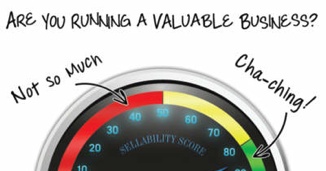 Most of us know the FICO score is a critical element lenders use to determine such things as our personal creditworthiness and corresponding maximum available loans and interest rates. Of course, a number of other factors such as debt-to-income ratio, employment history, general credit history and other specific underwriting policies may also be used by lenders to decide the amount and terms of credit being extended.
Most of us know the FICO score is a critical element lenders use to determine such things as our personal creditworthiness and corresponding maximum available loans and interest rates. Of course, a number of other factors such as debt-to-income ratio, employment history, general credit history and other specific underwriting policies may also be used by lenders to decide the amount and terms of credit being extended.
We also know that we may be able to increase our FICO scores over time by practicing responsible personal financial management. But there is an even more significant score for shop owners contemplating a sale of their business called the “Sellability Score.”
Just as the FICO score has evolved in its significance as a factor in the credit process, the Sellability Score is being utilized by a growing number of prospective business buyers to determine whether or not an asking price is justified.
Are You Running A Valuable Business?
It’s fun to imagine how much your business is worth. It’s not as much fun when you find out that for all the energy you poured into it, a business broker or potential buyer can’t see the value you can, or thinks your number is unrealistic.
“Sellability” is a powerful indicator — regardless of whether or not you have any intention or interest in selling your business today — because it points directly to the underlying issues in your business that may undermine your value. Those same issues are probably causing mounting frustration for you — the feelings of being overwhelmed, working too many hours, dealing with inconsistent customer experiences and the difficulties of managing cash flow.
Whatever your personal and financial goals are for your business, as a responsible business owner, you simply have to be able to answer these questions:
• If you wanted to, could you sell your business today for a number that you’d be happy with?
• Is there anything that you could be doing each day to make your business more valuable?
• What steps can you take to reduce the number of hours that you work, while simultaneously boosting the profits and the sellability of your business?
The “Sellability Score” can assist you in answering these questions.
Whether you want to sell next year or a decade from now, or pass the business to a family member, you strive to build a branded asset that someone would value monetarily — otherwise, you just have a job, not a business.
The Sellability Score is an interactive tool offering a comprehensive assessment of the “sellability” of your business. In just 26 minutes, this absolutely free and confidential self-assessment tool will score your business in a number of key areas and tell you just how sellable your business is. Thousands of business owners worldwide have benefitted by participating in this free questionnaire.
To make the Sellability Score even more pertinent to the automotive aftermarket, I have supplemented the standardized online questionnaire with an additional set of questions designed specifically to examine the key factors used by buyers to determine which auto service business to buy and how much to offer. Each questionnaire takes about 13 minutes to complete.
How Does It Work?
All you need to do is visit my website www.art-blumenthal.com and click on the button for the Sellability Score. You will see links for both the standardized and the aftermarket specific questionnaires.
When you complete the two parts of the Sellability questionnaires, you’ll receive:
1. A standardized Sellability Score that ranks your business among all other businesses, and
2. An aftermarket Sellability Score that evaluates the sellability of your business compared to other automotive service businesses.
The standardized Sellability Score, a scale of zero to 100, is based upon key drivers of sellability, which are statistically proven to increase the value of your company. The developers of the tool studied 6,955 businesses and correlated the positive and negative attributes of each business with their ultimate selling price compared to similar businesses.
The aftermarket Sellability Score drills down deeper into the details of your business and pinpoints key elements that are most attractive to aftermarket buyers. Your responses, as well as other publicly available data about your area and location will be analyzed to provide an assessment of how your business compares to other automotive businesses in terms of sellability. The aftermarket sellability key factor analysis is based on my 37 years in the automotive aftermarket and successfully selling dozens of automotive businesses.
Last year, I represented a seller whose business was so sellable it was under contract with a buyer in two days, with a 10% premium over what the seller thought it was worth. Other less sellable businesses took two years to find a qualified buyer. The higher your Sellability Score, the less time it will likely take to sell your business and the more money you will get for it.
The Science Behind The Score
The Sellability Score algorithm was developed using a quantitative survey of business owners and is continually refined, based on the thousands of business owners who get their score each quarter.
Is your business your largest asset? Achieve a Sellability Score of 80+ out of a possible 100 and, based on research from thousands of test cases, your shop may be worth 71% more than the average business.
Your overall Sellability Score is derived from your performance, based upon your answers to 32 questions, on the following eight attributes that drive the value of your company:
1. Financial Performance
2. Growth Potential
3. The “Switzerland Structure”: How dependent your business is on any one employee, customer or supplier.
4. The “Valuation Teeter-Totter”: Whether your business is a cash drain or a cash spigot.
5. The Hierarchy of Recurring Revenue: The proportion and quality of automatic, annuity-based revenue you collect each month.
6. The Monopoly Control: How differentiated is your business from competitors in your industry?
7. Customer Satisfaction
8. Hub & Spoke: How your business would perform if you were unexpectedly unable to work for a period of three months.
The majority of buyers who contact me don’t want to be a slave to the business and work every hour that the business is open. In fact, many buyers already own a business and are looking to supplement their income by purchasing an additional business where they will provide part-time supervision and marketing and business acumen. These buyers will pay a premium for a business that can clearly demonstrate its ability to run profitably without the seller as the critical hub.
Article Courtesy of Shop Owner











